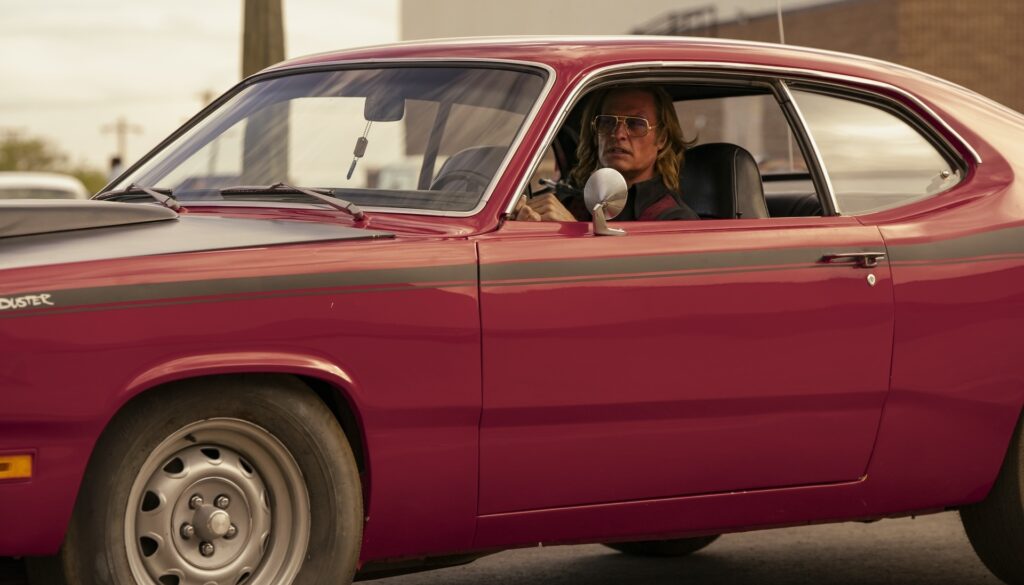What’s Going On?
We’re on episode three out of eight in the season, and I still don’t care about any of the characters in HBO Max’s far out thriller Duster.
The frustratingly vague storytelling, which introduced too many characters at the beginning, is spinning its wheels, trying to move forward while leaving many unanswered questions behind. At least now we know a small detail about the cherry red lead, the 1970 Plymouth Duster. In a scene where Saxton mentions to Jim that he remembers when his dead brother bought the Duster.
Considering the show is set in the presumed year of 1972, and the car is 1970, that would mean Jim’s brother has only been dead for less than two years
I can never remember the brother’s name because I simply don’t care because the only things I know about him are incredibly vague. Apparently, he was the best dude to ever live but I don’t know because I’ve never seen his face.
Moreover, if the car represents a sentimental vessel of his brother’s memory, why is Jim using it as a work car? Why risk having such an emotionally valuable car getting wrecked or turned into evidence?
A Wasted Time and Potential
It’s incredible how a show with nearly hour-long episodes set in an organically captivating era, can waste so much potential with skin deep character depth.
It’s a show about a wheelman, yet I haven’t seen any cinematic car chase scenes in the last two hours of combined show time. The cinematography is flash over substances, revving the engine but never shifting into drive. Even the fight scenes seem to drag on, with every punch feeling like it takes 30 seconds to land.
They keep teasing a government cover-up, which prompts the question, why are two rookie FBI agents allowed to continue their investigation? Reassign them to a different case.
Speaking of FBI agents, what happened to the two dorky-looking white FBI agents introduced as possible bullies to the minority characters; we haven’t heard from them in ages. The same goes for the supposed Mexican cartel boss Jim signed a contract to work for in his own blood. No consequences for Jim flaking? How many days have passed? Has all this happened in the span of a weekend?
The pacing of this show is frustrating, wasting so much time setting up more questions instead of answering questions we’ve been wondering for weeks.
The most prominent criticism is with the Duster itself, which, up until now, has not been treated like the star of the show. It’s a main character without any good lines or action. By now, I’ve already forgotten the two-minute car chase scene from the first episode.

Cringy Dialog and Characters
There are so many great movies and TV shows from the early 70s the Duster‘s writing and production team could have watched as research. The dialogue in Duster comes off sounding inauthentic and corny. It sounds like the writing team wrote the episode and forgot it took place in the 70s and went back to add a, “dig it.”
What little humor in the show is confusing. I’m unsure when or what is supposed to be comedic relief – if any. The lead wheelman, Jim, has zero charisma, letting his smile do most of the talking. As a character, he’s not suave like Jim Rockford or funny like Colt Seavers, and definitely not clever like Kojak; he’s just blonde hair and bleached teeth.
Plus, the show made the only Native American character a comic book nerd with a thing for Superman. That’s incredibly lame and a wasted opportunity for an interesting character. The comic book fan trope is dead.
He could have been given an edge like maybe he’s into Pink Floyd before Dark Side of the Moon hit the charts in 1973, or a big fan of Redbone, which was moving in grooving in the early 70s, delivering hits like “The Witch Queen of New Orleans”, “When You Got Trouble”, “Jericho”, and their most famous song, “Come and Get Your Love” – although that single didn’t release until 1973.
Speaking of music, episode three features the song “Foxy Lady” by Jimi Hendrix, a song from 1967, and doesn’t fit the vibe of the early 70s as Hendrix died in 1970 with the 1960s. This is another wasted opportunity to introduce an underrated musical gem to a new generation.
No Turning Back Now
I’m three episodes deep into reviewing this show. I can’t turn back now, but I’m not happy about continuing either. The show desperately needs to pick up the pace and stop dragging its feet. Any action that happened in episode three left us with more questions and I’m getting tired of waiting for a pay off in a show about a fast driver.





Comments
Loading comments...
Failed to load comments. Please try again later.
Leave a Comment